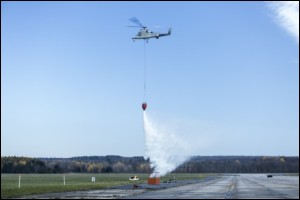Self-flying helicopter for fighting wildfires
 Fighting a wildfire requires a lot of manpower and a lot of equipment, including helicopters and airplanes for aerial support. The problem with the humans in those aircraft, however, is not only that do they put their lives at risk—and sometimes lose them—they’re not actually very efficient. Pilots need to do things like eat, use the bathroom, and sleep. That means spotter planes and water bombing helicopters spend more time on the tarmac than they do actually fighting fires. That’s why Lockheed Martin decided to take the self-flying helicopter it developed for the battlefields of Afghanistan and send it to the combustible forests of the United States. The K-MAX, produced by Kaman Aerospace and outfitted for autonomous flying by Lockheed, flew thousands of missions in Afghanistan between 2011 and 2014, carried more than 4.5 million pounds of cargo, sometimes through areas that would be considered unacceptably risky for human pilots.
Fighting a wildfire requires a lot of manpower and a lot of equipment, including helicopters and airplanes for aerial support. The problem with the humans in those aircraft, however, is not only that do they put their lives at risk—and sometimes lose them—they’re not actually very efficient. Pilots need to do things like eat, use the bathroom, and sleep. That means spotter planes and water bombing helicopters spend more time on the tarmac than they do actually fighting fires. That’s why Lockheed Martin decided to take the self-flying helicopter it developed for the battlefields of Afghanistan and send it to the combustible forests of the United States. The K-MAX, produced by Kaman Aerospace and outfitted for autonomous flying by Lockheed, flew thousands of missions in Afghanistan between 2011 and 2014, carried more than 4.5 million pounds of cargo, sometimes through areas that would be considered unacceptably risky for human pilots.
Further reading at wired.com
Image credit: Lockheed Martin




